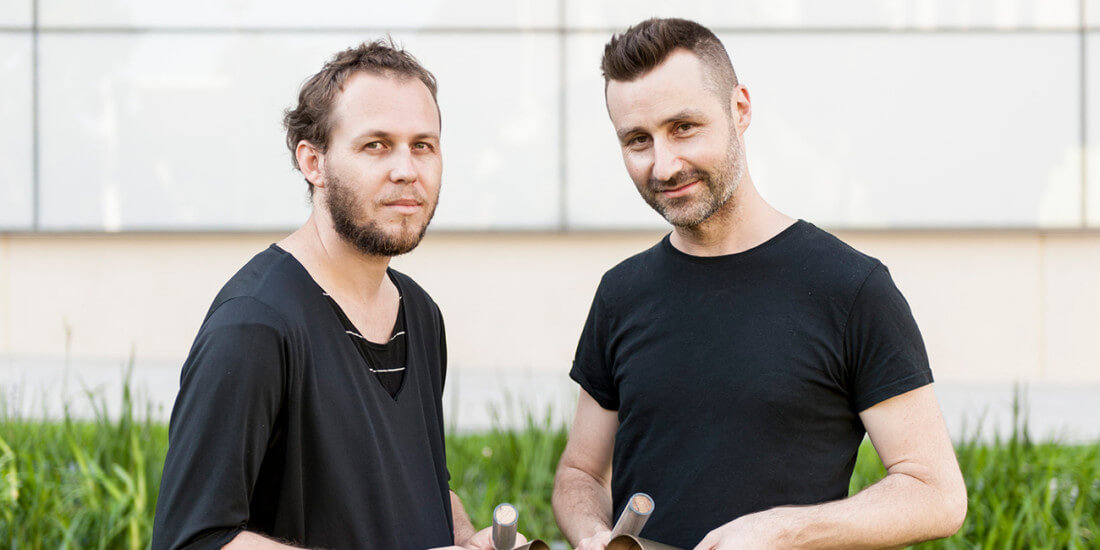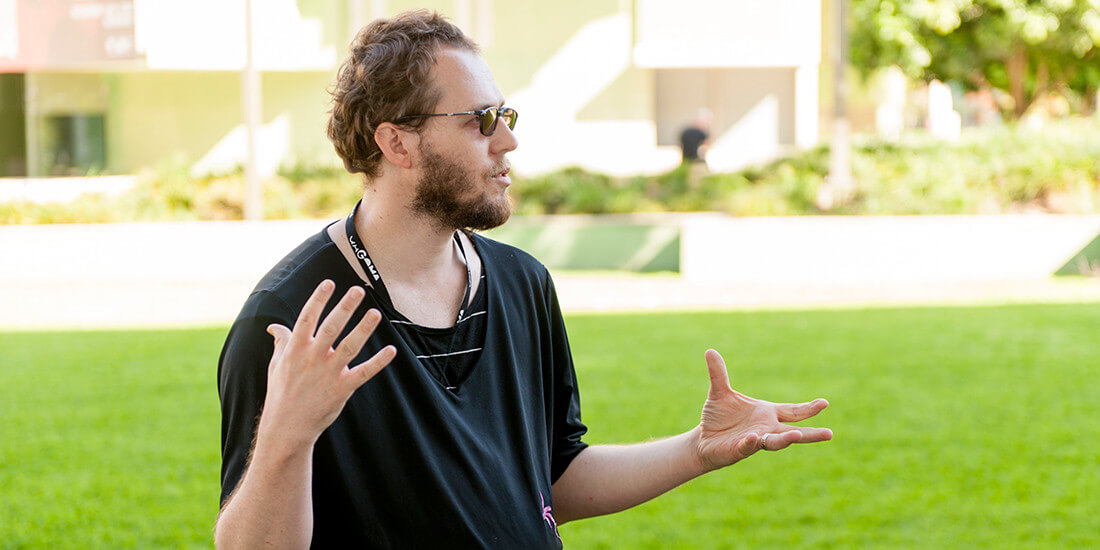Luke Jaaniste, sound artist, Super Critical Mass
To find a way to make a group of strangers come together and quickly cooperate without a leader, I think that’s quite beautiful and joyous ...
Luke Jaaniste is one of Brisbane’s preeminent creators of sound art. After studying composition at Brisbane’s Conservatorium of Music, Luke split from conventional music writing to examine how sound interacts with space. Luke linked up with fellow sound artist Julian Day in 2007 to form Super Critical Mass, a sonic-spatial project that creates pop-up happenings utilising the same objects to create sound, played by varying collections of people. For the final weekend of APT8, Super Critical Mass is inviting people to come and participate in two large-scale ambient works involving the gallery space and Federation Handbells, aiming to fill the space with beautiful sound. Ahead of the final APT8 Live on April 9–10, we had a chat with Luke about the evolution of sound art and how Super Critical Mass will take shape at QAGOMA.
Can you remember the first time you were captivated by art?
In any form? (laughs) It depends on what you think art is. I think of art as a way of reprocessing what is possible to experience from the world. Science will analyse it, measure it and predict it, and history will talk about what happened and sociology can try and make measurements and predictions at a human level. Art – and also engineering – are the kind of practices, which actually change what is possible to experience at all. At that level, I just think of the experiences I had as a little kid, which I remember quite fondly as being quite pivotal in a way. When I was four my mum would walk me up the hill of a paddock of a neighbouring farmhouse. We were out in a small country town. We’d stand at the ridge at one side of the valley that we lived in. To see the entire horizon around me and to feel like my body was expanding across the valley to the other side and all of it was mine for the enjoying was really quite a pivotal experience. Another version of it was walking to the river behind our house and get rocks and build bridges and sculptures in the river that would interact with the flow of the water and change the course of the creek.
What was the first time you dabbled in art of your own?
I don’t remember this but apparently when I was young I would paint red monochrome after red monochrome at kid’s playgroup. My mum would stick butcher’s paper on the wall of our house and all the farmers’ kids would come over and paint. While they’d paint figures and houses I’d just get the red paint and cover each bit of paper with red. Back then I was excited about these gorgeous, lush, all-encompassing experiences.
It seems like art has been something that has stuck with you from a young age, but was there a catalyst that sparked your desire to create art of your own?
Yeah, those previous events were really pivotal lifetime experiences. As a teenager – when I was about 14 or 15 – I had learned piano from the time I was in primary school but as a young teenager I saw some other kids singing their wn pop songs at a high school camp. It was the first time that I realised that you could create music yourself; you didn’t have to play it based on compositions. It was such an obvious idea to anyone that has grown up with music but because I had a classical tradition, the idea that you composed your own music wasn’t even on the radar. When I saw these other kids do it I thought I could too and I went off and started composing makeshift, wannabe, classical pieces – that was the specific trigger that then led me to apply to and get into the Queensland Conservatorium of Music with a composing portfolio. That was around the time that I met Julian who is the other significant director of Super Critical Mass.
People often say there is a fine line between music and art – some think they are the same – when did you make the distinction between not being musician but as a sound artist?
I never felt like a muso. Only now do I call myself a musician because it’s only been in the past year that I have been performing sets of music in front of people in that ‘band’ kind of way. I was painting and drawing and doing visual art in high school as well, but for whatever reason it was the challenge and the emotional feeling of composing music that I wanted to go with. When I went to University I kept up my visual artwork and that turned into a site-specific installation art practice and then Julian and I started to do these really quirky, middle of the night performance art works around the streets of Brisbane.
So is that how Super Critical Mass took shape and existed in the early days?
Yeah, we were doing our street performances while being trained to be composers at The Con, so in our undergraduate year there was a sense of this other world of performance that I wanted to be part of. It was with Julian that we first started trying that out – we formed a performance art duo during the University days and we started to work on music outside of the Concert Hall. The Conservatorium had enough trouble coping with the music we were composing to even care about the other stuff, so we never even showed it to them.
Obviously throughout art history, visual art has largely been the more appreciated form. These days, in terms of recent history, sound art has only newly risen to prominence. What do you think has changed to put sound art in focus?
In terms of musical and visual culture, those things have been going on for thousands of years – so there is nothing in a sense new about people working with sound and people working in performance and space. What is new is how much the gallery and museum institutions take notice of any of that. A lot of history of visual art is paraded as a history of moments of the museum noticing something. People were working with everyday objects and the beauty of the mundane and turning them into sculptures well before Duchamp and his friends took the urinal into the museum. It was at that moment that people noticed that the museums were looking at it. I don’t want to claim anything new about the idea of sound art but certainly the galleries have taken notice of it more and more in the past few decades.
How does that shift affect what you are doing with Super Critical Mass?
For Super Critical Mass it does give us a context that is really interesting – we needed a context where we are working with local participants and audiences where they are okay with the idea that they are going to come and attune their listening and they are going to have a musical experience. We are going to tweak the fine grain listening skills and work with a set of beautiful acoustics and aesthetics that we are used to from the fine art of concert hall music. We also want people to come and relish in the idea that these sounds are coming all around you and that it is about taking this listening musical aesthetic into the everyday ambience of the space that surrounds them, and that they might think about these as much as games or performance processes as music. In that sense the museum and the Gallery of Modern Art are great places to do that because people can go there expecting not just see paintings on walls but also because of the last half-century of work and performance art and sound art and process art people can now come to expect that their own performance actions – where they are standing in the building or how they are choosing to do what’s next – is part of the materials of making art now. That’s one ideal context for Super Critical Mass – we also work outdoors and in pedestrian settings, we’ve worked in some musical settings but never on the stage. The gallery is this beautiful open platform for that.
How important is the idea of utilising space to the project as a whole? When Super Critical Mass started was it about creating sounds that broke out of the environment of the Con or was it more about using spaces to facilitate a greater appreciation of noise?
Yeah, space was always there at the beginning. There were a few key ingredients that began in 2007 and 2008 that haven’t changed. First we said, “let’s do groups of people that are playing the one sound source” – it used to be more musical instruments like flutes, trumpets and clarinets. Now it’s any sound source that can make an interesting sound but that might be more accessible to people like bells or pieces or paper, tapping wooden tables with coins and the like. Groups of people making the one kind of sound dispersed in a space that highlights and expands on the acoustics and the architecture of the space as well as giving us a new way of moving through and appreciating that space. We’ve never had music stands, we don’t have conductors and we don’t have a leader to follow – everyone has an instruction that is given verbally and then as a group they each undertake that instruction in their own way but in relation to space and each other. Over an hour or so this event, ritual or sound world unfolds – it can’t happen without space.
So how have you gone about piecing together the work at GOMA for APT8 Live?
We’ve been doing numerous workshops at GOMA over the past few months trying things out. We’ve been trying out the bells and figuring out how people might want to use them. We ask ourselves what does it sound like in one part of GOMA, or in the older part of the Queensland Art Gallery? What about when you can hear the bell but you cant see it because you are hiding throughout the walkway areas? What is it like to look across the long corridors and try and synch up your bell ringing with one 50 metres away? How are all those spatial interactions experienced? We don’t think of an idea and take it to a space; we develop the idea in the space.
Aside from people coming to GOMA and experiencing the sounds passively, how will the performance work exactly?
One of the ways people can experience Super Critical Mass at GOMA is by being a direct participant. People can come in the afternoon of the Saturday and Sunday of the closing weekend and hear it, but if they turn up at 11:00 am on either day they can check in their bags and meet in the larger room and get some instruction on how to take part. Each person receives a bell that is his or hers for the day and we have some light lunch then we spread out and perform together that afternoon. Because we have done all those workshops and trials, when it gets to the day of the performance we can just give a simple instruction. If there are lots of people doing it slightly differently, it creates this network or cloud of sound. It’s quite a unique thing that people can get involved in because it’s a rare chance for them to join up and be part of a large bell choir and be part of making sounds in GOMA where normally you have to be hushed. (For an insightful look at Super Critical Mass at APT8, watch an interview with Dr Kyla McFarlane, Curator, Australian Art).
What do you hope someone engaging with Super Critical Mass at GOMA takes away from the experience?
Often people’s first experience is a subtle discovery. We play with the threshold of audibility – can you hear it, what’s happening, how many bells are there, where are they coming from? All of these factors at play mean that you are teased into discovering the space more. Maybe you’ll go wander to find those bells but then you’ll hear some behind you, making you do a double take. As people start to understand what they are part of it becomes a slow unfolding that is quite a contemplative experience of the space that they might have been to in the past but there are areas of it that they might have never explored or noticed. Especially with GOMA and QAG is the single vastness of the entire building – often when you go to these galleries you are looking at a fraction of a wall for one artwork. The rest of the gallery is just a thoroughfare. We are seeing all of the spaces and all of the corridors that are connected as part of one body of air, the one sonic space that you can appreciate in its fullness.
A lot of your work involves audience participation in some way, is there a joy in seeing people interact with your work?
They are the work! Well, we make the work together! The interaction starts with us in these trials and workshops where some smaller group of people come in and take the whole journey with us and we try things out here and there. We build it up over time and when everyone comes together there is this beautiful thing where strangers are cooperating in the most attuned way – it’s not often that you’ll get strangers being sensitive to each other. In public spaces we learn to look after ourselves. We like to people watch in public space, though. To find a way to make a group of strangers come together and quickly cooperate without a leader, I think that’s quite beautiful and joyous.
To secure your spot as part of the Super Critical Mass project, contact GOMA at [email protected] then turn up at 11:00 am for instructions. Be sure to stick around and enjoy the remainder of APT8 while you are there.


